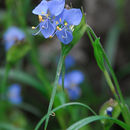Comments
provided by eFloras
Two varieties have been recognized: Commelina dianthifolia var. dianthifolia (Arizona, New Mexico, Texas), with the spathes gradually tapering into a long, acuminate apex, and C. dianthifolia var. longispatha (Torrey) Brashier (Arizona, Colorado, New Mexico), with the spathes abruptly narrowed below the middle into a long, attentuate tip (C. K. Brashier 1966). Although most U.S. specimens are readily separable into these taxa, their ranges and ecologies overlap very broadly in Arizona and New Mexico. Until their variation in Mexico is studied, I can see no useful purpose in maintaining these varieties.
- license
- cc-by-nc-sa-3.0
- copyright
- Missouri Botanical Garden, 4344 Shaw Boulevard, St. Louis, MO, 63110 USA
Description
provided by eFloras
Herbs, perennial, unbranched to usually sparsely branched. Roots tuberous. Stems erect to ascending. Leaves: blade linear to linear-lanceolate, 4--15 ´ 0.4--1 cm, apex acuminate, glabrous to puberulent. Inflorescences: distal cyme usually 1-flowered, exserted; spathes solitary, green, often suffused and/or striped with purple, pedunculate, falcate or not, 2.5--8 ´ 0.7--1.7 cm, margins distinct, scabrous, not ciliate, apex acuminate, glabrous to puberulent; peduncles 1.5--9.5 cm. Flowers bisexual and staminate; pedicels puberulent; petals dark blue, proximal petal somewhat smaller; staminodes 3; antherodes yellow, cruciform. Capsules 3-locular, 2-valved, 5--6 mm, apiculate. Seeds 5, brown, 2.2--2.7 ´ 1.7--2.2 mm, rugose, pitted.
- license
- cc-by-nc-sa-3.0
- copyright
- Missouri Botanical Garden, 4344 Shaw Boulevard, St. Louis, MO, 63110 USA
Habitat & Distribution
provided by eFloras
Flowering summer--fall. Rocky soils; Ariz., Colo., N.Mex., Tex.; Mexico.
- license
- cc-by-nc-sa-3.0
- copyright
- Missouri Botanical Garden, 4344 Shaw Boulevard, St. Louis, MO, 63110 USA
Commelina dianthifolia: Brief Summary
provided by wikipedia EN
Commelina dianthifolia, known as the birdbill dayflower, is a perennial herb native to mountains in the south-western United States (Arizona, Colorado, New Mexico, Texas) and northern Mexico. Petals are blue while sepals are green. The inflorescence is a scorpioid cyme and it is subtended by a boat-like spathe.
- license
- cc-by-sa-3.0
- copyright
- Wikipedia authors and editors

